#West Francia
Text
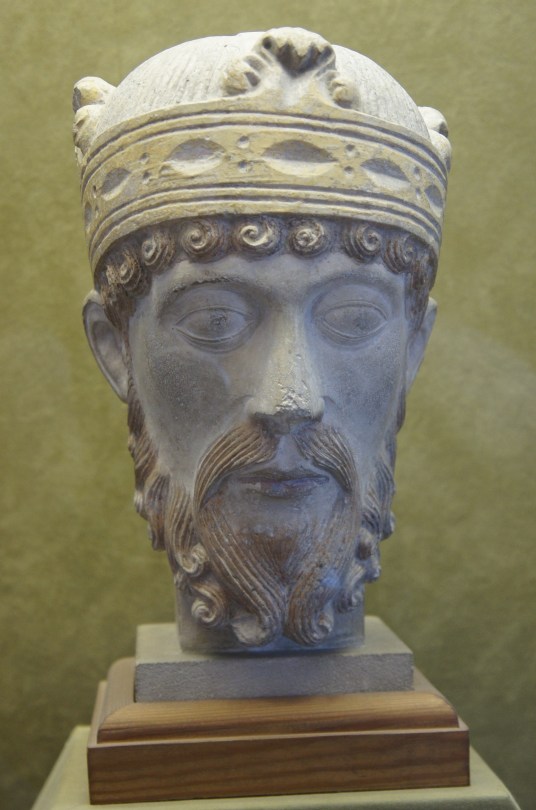
Lothair of France, king of West Francia (954-986)
Father of Archbishop Arnulf who was mentioned in previous post
Attribution: G.Garitan, CC BY-SA 4.0 https://creativecommons.org/licenses/by-sa/4.0, via Wikimedia Commons
#Lothair of France#West Francia#king#Carolingian dynasty#Franks#medieval#art#bust#10th century#12th century
46 notes
·
View notes
Text

The Death of Robert le Fort in the Battle of Brissarthe, 866 by Henri Lehmann
The Battle of Brissarthe was fought on 2 July 866, between the Franks and a joint Breton-Viking army near Brissarthe, Neustria. It was marked by the death of Robert the Strong, the Neustrian margrave, and Ranulf I, the duke of Aquitaine.
#battle of brissarthe#death#robert le fort#robert the strong#franks#bretons#vikings#brissarthe#neustria#neustrian#art#henri lehmann#history#europe#european#knights#medieval#middle ages#france#west francia#kingdom of the west franks
26 notes
·
View notes
Text
Rollo, the legendary Viking warrior, invaded France and laid siege to Paris more than once. In the end, the French made peace with him and he was allowed to start a dynasty in the area known as Normandy today.
#Rollo#Duke of Normandy#Ragnar Lothbrok#Viking leader#West Francia#paris#Siege of Paris#Burgundy#Dudo of Saint-Quentin#Carolingian Empire#Charlemagne#ancient#history#ancient origins
36 notes
·
View notes
Photo

Pondering
#vinland saga#BJOOOORN#askeladd#askebjorn#vs askeladd#vs bjorn#my art#fanart#the raid to west francia was worth the epiphany#maybe
513 notes
·
View notes
Text



I’ve watched an old film called “shot through the heart (1998)” I realized two kings from Vikings in it fighting together 😘
Actually, this is heat braking story but quite good one.

This is based on the true story. An article called Anti-Sniper by John Falk (published in the November 1995 issue of Details magazine).
#shot through the heart#snipers#Vikings#linus roache#Vlado Selimović#Ecbert the king of Wessex#lothaire bluteau#Zijah#Emperor Charles of west francia
5 notes
·
View notes
Text
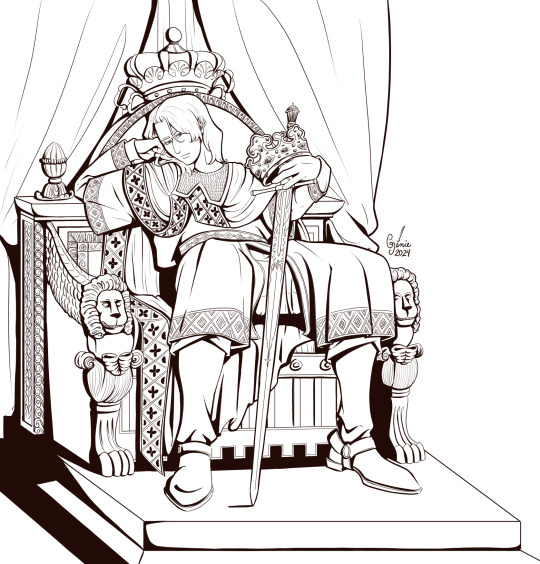
The House of Capet.
987-1328
The Capetian dinasty was the first French dinasty resulting after the death of Louis V (c.967-987) last Frankish king of the Carolingian Empire. In my HC, this Frankish personification is father of both France and HRE, and also Austria. After the colapse of the Carolingian empire, the Kingdom of Francia disappeared and the empire was partitioned in three big territories; West Francia (France), East Francia (HRE) and Middle Francia (the territories that the both of them will be fighting for in the centuries to come, the Benelux spawned from those territorial wars in between them, as well and Switzerland and everything in between).
France and the Holy Roman Empire would become natural enemies, then, as Franco's inheritance would be the same as that of the Carolingian Empire; to become the next Roman Empire. And both kingdoms would spend the rest of the centuries until the World Wars trying to achieve that inherited goal. It has a name, in fact; Franco-German enmity.
Hence, then, the name Holy Roman Empire, from the intentions to become the next great empire uniting the three continents. France is the older son, by the way. The Frank had... a little favoritism towards the youngest, because it was identical to him. And more visibly German, of course. This fueled the competition between the two and the hereditary and historic animosity between the two "princes".
It was the Franks that started the monarchical rule, feudalism and the hereditary rule for the sons in Europe. So France, HRE and Austria would be the first princes, haha.
#hetalia#aph fanart#aph france#francis bonnefoy#hws france#historical hetalia#myart#As always this are my HCs based on historical events#no one has to agree with them or anything
222 notes
·
View notes
Text
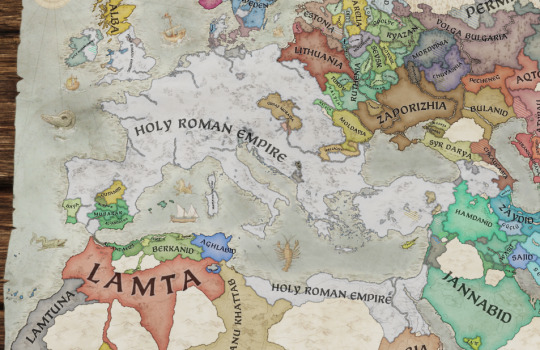
spent basically all of today, literally since i woke up, so that i could continue my west francia -> Carolingian borders Francia -> HRE -> Roman Empire game. doing really really well, no factions getting ready to rebel and I'm making like, 100 gold, max level of fame and faith, dynasty is currently uh "glorious"? i think? i don't remember the names. Ruler is a witch and I'm in the process of converting the dynasty so that i can found a coven, and i mended the great schism. Currently I'm only missing Tunis and uh, Antiochia i think, to reform the Roman Empire, but it's currently 3am and i need to go eep.
As for what I did today specifically, got rid of Byzantium, vassalized egypt, everything east of Polabia and south of Croatia has only been taken today, same for Denmark and everything that i have in England. Iberia is being slowly taken apart by my vassals in the area. Got max crown authority and i think half of the early medieval innovations. I consecrated my bloodline too, and I'll likely be strengthening it too the next time i play, i did a lot of inbreeding to get those congenital traits.
anyways, basically it's like 1020 and the roman empire is just about reformed. Fuck yeah.
55 notes
·
View notes
Photo
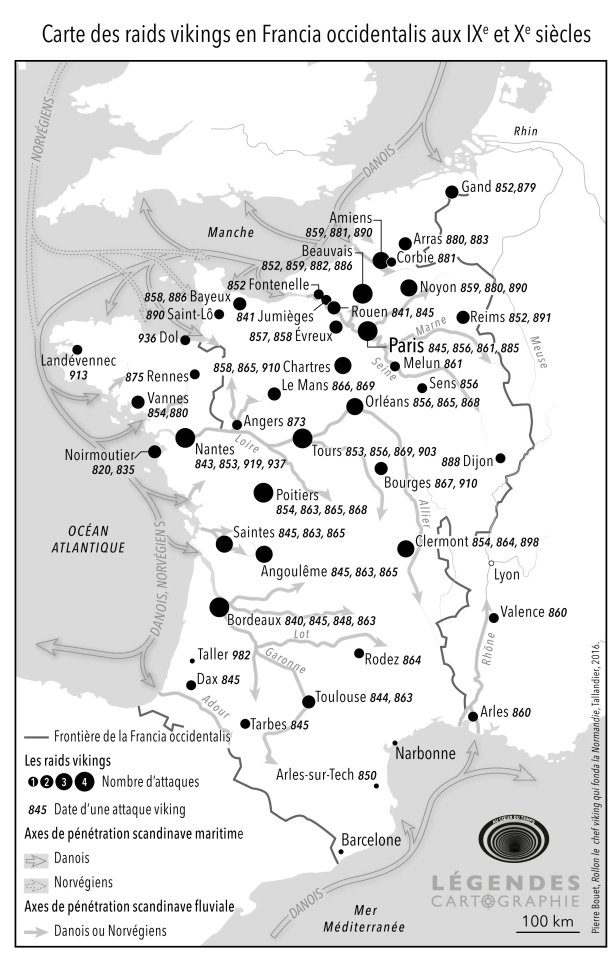
Viking raids in West Francia, 9th century.
by @LegendesCarto
87 notes
·
View notes
Text

Beast of Gévaudan
In the mid 18th century women and children were found torn apart, dismembered, or decapitated in the quiet French province of Gévaudan. These were the first of nearly a hundred attacks perpetrated by a mysterious animal dubbed as the Beast of Gévaudan.
From 1764 to 1767, in the historical region of Gévaudan, located in southern France, and in adjacent areas, about one hundred children, youths, and women were killed by a so-called “Beast”. Numerous other humans survived the attacks, many of them seriously injured. The series of attacks has been confirmed by a great variety of historical documents and is not called into question by scientists.
Historians claim that wolves, or a hybrid of a wolf and a domestic dog, had attacked the victims; the “hybrid-assumption” is based on the description of a canid, shot in June 1767, that was said to have strange morphological characteristics. However, a critical evaluation of historical texts, including the publications of the French abbots François Fabre and Pierre Pourcher, revealed that neither this animal, nor any other wolf killed in Gévaudan, had anything to do with the attacks of the Beast.
Descriptions of the time vary, and reports may have been greatly exaggerated due to public hysteria, but the Beast was generally described as a wolf-like canine with a tall, lean frame capable of taking great strides. It had an elongated head similar to that of a greyhound, with a flattened snout, pointed ears, and a wide mouth sitting atop a broad chest. The Beast’s tail was also said to have been notably longer than a wolf’s, with a tuft at the end. The Beast’s fur was described as tawny or russet in colour but its back was streaked with black and a white heart-shaped pattern was noted on its underbelly.
About 95 percent of the carnivore attacks on humans in Gévaudan during the years 1764 to 1767 can be attributed to that single animal that was referred to as la bête: The Beast. There is no doubt that the remaining attacks were executed by rabid and non-rabid wolves. Wolves were a common species at that time and therefore easily recognized by the rural population.
The Beast of Gévaudan committed its first recorded attack in the early summer of 1764. A young woman named Marie Jeanne Valet, who was tending cattle in the Mercoire forest near the town of Langogne in the eastern part of Gévaudan, saw the Beast come at her. However, the bulls in the herd charged the Beast, keeping it at bay. They then drove it off after it attacked a second time. Shortly afterwards the first official victim of the Beast was recorded: 14-year-old Janne Boulet was killed near the village of Les Hubacs near Langogne.
Throughout the remainder of 1764, more attacks were reported across the region. Very soon terror gripped the populace because the Beast was repeatedly preying on lone men, women, and children as they tended livestock in the forests around Gévaudan. Reports note that the Beast seemed only to target the victim’s head or neck regions.
On January 12, 1765, Jacques Portefaix and seven friends were attacked by the Beast. After several attacks, they drove it away by staying grouped together. The encounter eventually came to the attention of King Louis XV, who awarded 300 livres to Portefaix and another 350 livres to be shared among his companions. The livre was the currency of Kingdom of France and its predecessor state of West Francia from 781 to 1794. The king also directed that Portefaix be educated at the state’s expense. He then decreed that the French state would help find and kill the Beast.
The killing of the creature that eventually marked the end of the attacks is credited to a local hunter named Jean Chastel, who shot it at the slopes of Mont Mouchet, now called la Sogne d’Auvers, during a hunt organized by a local nobleman, the Marquis d’Apchier, on June 19, 1767.
29 notes
·
View notes
Photo

Beast of Gévaudan
In the mid 18th century women and children were found torn apart, dismembered, or decapitated in the quiet French province of Gévaudan. These were the first of nearly a hundred attacks perpetrated by a mysterious animal dubbed as the Beast of Gévaudan.
From 1764 to 1767, in the historical region of Gévaudan, located in southern France, and in adjacent areas, about one hundred children, youths, and women were killed by a so-called “Beast”. Numerous other humans survived the attacks, many of them seriously injured. The series of attacks has been confirmed by a great variety of historical documents and is not called into question by scientists.
Historians claim that wolves, or a hybrid of a wolf and a domestic dog, had attacked the victims; the “hybrid-assumption” is based on the description of a canid, shot in June 1767, that was said to have strange morphological characteristics. However, a critical evaluation of historical texts, including the publications of the French abbots François Fabre and Pierre Pourcher, revealed that neither this animal, nor any other wolf killed in Gévaudan, had anything to do with the attacks of the Beast.
Descriptions of the time vary, and reports may have been greatly exaggerated due to public hysteria, but the Beast was generally described as a wolf-like canine with a tall, lean frame capable of taking great strides. It had an elongated head similar to that of a greyhound, with a flattened snout, pointed ears, and a wide mouth sitting atop a broad chest. The Beast’s tail was also said to have been notably longer than a wolf’s, with a tuft at the end. The Beast’s fur was described as tawny or russet in colour but its back was streaked with black and a white heart-shaped pattern was noted on its underbelly.
About 95 percent of the carnivore attacks on humans in Gévaudan during the years 1764 to 1767 can be attributed to that single animal that was referred to as la bête: The Beast. There is no doubt that the remaining attacks were executed by rabid and non-rabid wolves. Wolves were a common species at that time and therefore easily recognized by the rural population.
The Beast of Gévaudan committed its first recorded attack in the early summer of 1764. A young woman named Marie Jeanne Valet, who was tending cattle in the Mercoire forest near the town of Langogne in the eastern part of Gévaudan, saw the Beast come at her. However, the bulls in the herd charged the Beast, keeping it at bay. They then drove it off after it attacked a second time. Shortly afterwards the first official victim of the Beast was recorded: 14-year-old Janne Boulet was killed near the village of Les Hubacs near Langogne.
Throughout the remainder of 1764, more attacks were reported across the region. Very soon terror gripped the populace because the Beast was repeatedly preying on lone men, women, and children as they tended livestock in the forests around Gévaudan. Reports note that the Beast seemed only to target the victim’s head or neck regions.
On January 12, 1765, Jacques Portefaix and seven friends were attacked by the Beast. After several attacks, they drove it away by staying grouped together. The encounter eventually came to the attention of King Louis XV, who awarded 300 livres to Portefaix and another 350 livres to be shared among his companions. The livre was the currency of Kingdom of France and its predecessor state of West Francia from 781 to 1794. The king also directed that Portefaix be educated at the state’s expense. He then decreed that the French state would help find and kill the Beast.
The killing of the creature that eventually marked the end of the attacks is credited to a local hunter named Jean Chastel, who shot it at the slopes of Mont Mouchet, now called la Sogne d’Auvers, during a hunt organized by a local nobleman, the Marquis d’Apchier, on June 19, 1767.
64 notes
·
View notes
Note
i think hima left For the interpretation. But since he looks bigger than England and looks quite near age people usually make him on if the Frankish and Francia too. He's probably western France when the country was divided in three since the middle was quickly swallowed and the western was the part that stayed more or less unchanged through time. I do think his mother died and only then he got to live but I've seen people write him as if he was born much later.
does it change much if he's the son of Frankish though? Wait did he kill his brothers?
I am in no way a French historian - especially mediaeval France. But I know France is a bitch to 'date' because the concept of Frenchness covers a very small area of what's now France, at least until about Napoleon's time.
I agree however! I genuinely think that Charlemagne's empire was its own thing and the splinter into the three Francia's is what sprouted the France, HRE and... assorted dukedoms which eventually got swallowed up by the other two.
I had a draft post where I was desperately vomiting out my issues with carbon dating Francis because he is meant to be older than England but if you say Francis is France and not (West) Francia then Arthur has a good fifty years on him in age right? 927 for Aethelstan versus 987 for the start of the Capetians. Like I'm fairly certain Burgundy, Brittany etc. will have had to have had their own little nations running around. Normandy is also very likely. I know enough about French history to know that for much of the middle ages huge amounts of power lay with the Dukes who swore loyalty to the King of the Franks but that title of King could really be in name only at times etc....
I'm still trying to iron it out. If Francis is older than Arthur... he has to be West Francia. Right? If Gilbert can change who he actually is four times why can't Francis?
It then just makes me go down rabbit holes of 'hey okay wait a second how old is England then', because the concept of English is substantially older than the idea of French.
I'm trying to apply logic to a world system where - just as in real life - the ideology of a nation state is just... not functional (or at least deeply deeply flawed). It's especially not functional as a political unit to make a personification of in 10th century France.
I bet Francis did absolutely knock off the dukedoms one by one if given the chance. Like it took him like 1000 years but he eventually did it with East Francia/HRE too. I'd say more more about Burgundy/Lotharingia/Savoy/Aquitaine but honestly I don't bloody know how the French state functioned until the Bourbons took over. Still, let's say that, if Picardy exists (and is not a gag throw away character which he may well be) and yet Brittany doesn't I will be... very baffled.
I'll stop now. I'm really not knowledgeable in French history to try and iron this out. Also consistency in Hetalia is a losing battle. I know that. Logically. Cough cough.
7 notes
·
View notes
Text
Verdane / ヴェルダン
Verdane (JP: ヴェルダン; rōmaji: verudan) is the forested nation ruled by King Batu in Fire Emblem: Genealogy of the Holy War. The name is a corruption of the French city of Verdun (JP: ヴェルダン), likely inspired by the treaty tied to it. The Treaty of Verdun was signed by the three warring grandsons of Charlemagne: Lothair, Louis, and Charles. Their father, Louis the Pious, had divided the Frankish Empire into three kingdoms for his children, unified by his sovereignty. Upon Louis' passing, the eldest son Lothair wished to reclaim the title of emperor his father's decisions took from him. War broke out between Lothair and his younger brothers - united to deny him the imperial throne. After three years of conflict, Lothair would be bested in the Battle of Fontenoy, and a meeting to establish the Treaty of Verdun would commence. They would declare Lothair unfit for the imperial throne and divide the land into three separate kingdoms: West Francia, Middle Francia, and East Francia, the predecessors to modern France, Italy, and Germany.
The conflict between siblings seen in this period of Frankish history is reflected in the three princes of Verdane. Two of King Batu's sons, Munnir and Cimbaeth, have their goals aligned, while the heir to the kingdom - Jamke - holds opposing values to the rest of the royal family. Similar concepts are found in Munnir's Japanese name, which will be covered at a later date.
10 notes
·
View notes
Text
Haru's distorted persona: Adelaide of Italy (Adelaide)

Background: One of the most powerful women of 10th century medieval Europe, queen of Queen of West Francia and later the Holy Roman Empress. She was beloved by her subjects for her extravagant acts of charity that came to the detriment of the royal treasury.
So there is a lot more to this saint's story than what I put in the background but I couldn't fit it as I wanted the background to be how they'd look in game so a lot of cutting was done. Surprisingly enough,, this one was actually the hardest one for me to decide on as Haru cycled through about 5 other women before I settled on Adelaide.
Adelaide of Italy was first married to Lothair II but this marriage didn't last particularly long as Lothair was poisoned by his usurper, Berengar II who tried to force Adelaide into marrying his son, Adalbert. Adelaide refused and was imprisoned for this but she managed to escape with the help of a priest and she wrote to the most powerful man in Europe for help offering her hand in marriage to convince him. They had a successful marriage, producing 5 kids. She was a powerful influence at court during her son's regency but eventually got overthrown by her daughter-in-law. She was eventually restored to power after her son then daughter-in-law died leaving her the regent for her grandson. She eventually resigned once he was capable of ruling without her and dedicated her life to acts of charity and the church.
On a surface level, its already clear why Adelaide was chosen for Haru as Shadow Haru is assigned the Heavenly virtue of charity Adelaide is well known for her charity and is an empress so Haru's arcana comes into play as well.
Naturally there was at play in the decision to use Adelaide as much like Haru, she was put into difficult positions by the men in her life but she managed to claw her way out of these messes without compromising her beliefs.
Shadow Haru is being charitable with the people of the Phantom Thieves' utopia at the expense of the people the Phantom Thieves deem unworthy of their utopia. Much like how Adelaide's generosity to her people endangered the treasury. It's a kind act but people are being hurt by their actions as overcharging the people deemed problematic to society helps no one and while the royal treasury funds the extravagant lives of royals and the nobility, it is also used to pay for things such as the standing army, etc. so using up all the funds on charity, while a kind act, is quite reckless.
As stated before me and Krotus are not artists but for what Adelaide looks like, in her boss fight, she's a skeleton draped in the finest of cloth and jewelry with her 5 children at her feet and a gardening basket with the heads of the men who wronged her. Then when she takes the form of a persona the persona is more human and the severed heads are gone, she takes after Shadow Haru's forest witch appearance and has hands holding onto her wrist, hands and elbows in an intricate pattern to represent her as a symbol of female empowerment through female relationships (This symbol is inspired by Adelaide being the patron saint of widows and abuse victims)
#persona 5#p5#persona 5 au#p5r#persona 5 royal au#the perfect semester au#persona 5 royal#haru okumura#adelaide of italy#okumura haru#originally she was adelheid which is her name in german but we liked adelaide more lol
19 notes
·
View notes
Text
OCs: Visigothic Kingdom and Ostrogothic Kingdom
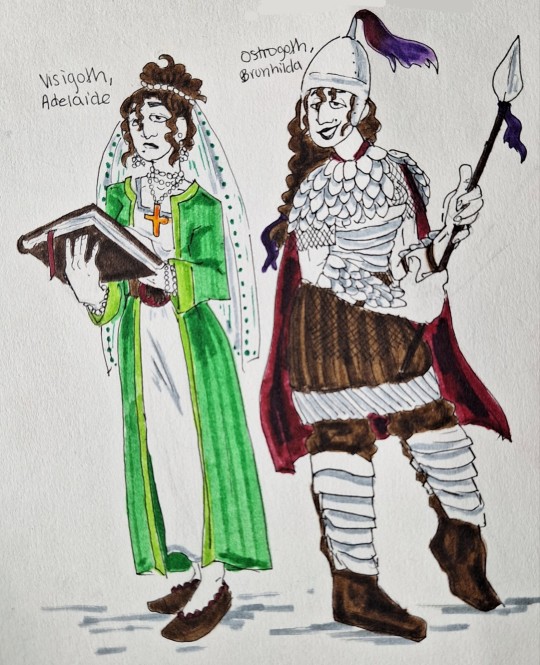
disclaimer: everything in history is complicated blah blah blah not everyone in these kingdoms was like that blah blah blah
Visigothic Kingdom:
Made an official nation in 418 AD (though existed for a few centuries earlier as a nomadic tribe), and died in 721 AD to the Umayyad troops under Al-Andalus. The nation sacked Rome in 410, which is widely regarded as the beginning of the fall of the Western Roman Empire. The kingdom then settled down in the Iberian peninsula (primarily Spain and parts of France). Though initially a pagan nation, the kingdom converted to Christianity in the mid-5th century.
The human name the personification chose was Adelaide, a Germanic name that meant "noble kind." She is just as much a soldier as her sister, having had a very rowdy teenagehood, but now prefers to stay away from conflicts when possible, instead focusing on diplomacy. She is neither talkative nor social, choosing to stay by her sister's side or in her own home. She keeps her distance from the Roman Empire after the sacking, and though she knows that she could beat him once more, she wants to focus her sights on more scholarly manners. She comes across and adopts a baby Spain, keeping him close by her at all times and teaching him what she feels is important for a young country to know- religion (with both Christian and Pagan elements), how to fight (though he's just a toddler), and basic grammar and rhetors. Once her sister died, she isolated herself and Spain to the best of her extent, uncomfortable with coming in contact with other nations, since she didn't know their true intentions.
Ostrogothic Kingdom:
Having existed for a few centuries prior like her sister, the kingdom officially became a nation in 469, just a few years before the Western Roman Empire fell and she took the land. She had mixed relations with Rome over the past few centuries, sometimes being lovers and occasionally mortal enemies, though they remained primarily friendly adversaries in 476, after she took what was left of the Western Roman Empire. Like her sister, she was initially Germanic pagan, but converted to Christianity in the early 5th century.
Her human name is Brunhilda, which in Germanic origin means "battle-ready." This is very indicative of her personality, fiery and always up for a battle. She keeps herself in warriors cloth, clad with a chainmail tunic, just in case anyone tries to stab her in the back. She is the closest with Adelaide, but she is much more social and willing to get to know (and fight) other nations. Her relationship with Rome is the most well-known, but she also has had brief interactions with Germania (The Frankish Empire) and the Vandal tribe in the south. Though she loved Spain as an aunt, she didn't invest much time in him, since she was dodgy around the concept of parenthood, and didn't want to fuck him up in any significant way.
She died in 553 AD, very young and tragically. Though she fought and took land bravely, she had a difficult time maintaining infrastructure, and the Gothic culture was something that couldn't be Romanized in the way she intended. The Frankish Empire (who we know as Germania) swept in and ended her reign with a blow to the back. She died in Adelaide's arms, mumbling prayers and apologies to any God she could remember.
Other Notes:
After the fall of the Western Roman Empire, Rome as we know him still existed, simply just the Eastern Roman Empire. He still saw himself as Rome, though around the time of the birth of the Holy Roman Empire, he retired his position as a nation and gave the official title to the Byzantine Empire, a teenage nation who was born at the fall of the West. He spent the rest of his retirement painting with Chibitalia, and died in the early 15th century, leaving Northern Italy to Austria.
Germania is the Frankish Empire (Francia, starting around 800 AD). Though the nation faced unstable shifts in power, the personification was strong and raised the children in the show that we know of (France, HRE, Teutonic Order/Prussia, Switzerland, Belgium, Luxembourg, and the Netherlands)
Spain was taken into the care of Umayyad Caliphate after the death of the Visigothic Kingdom, where he converted to Islam and grew into his teenaged years. The Spanish Umayyads fell in 1031 to Spain himself, and Spain converted back to Christianity in the late 15th century.
#historical hetalia#hetalia ocs#historical hetalia ocs#hws spain#aph spain#hetalia ancients#hws ancient rome#aph ancient rome#hws germania#aph germania#this is so long im so sorry#nobody is going to read this#yippee
23 notes
·
View notes
Text
Powerful queens

“There was a time (between the tenth and twelfth centuries) when the king’s wife acted as a consors regni alongside him, having been delegated a share of real power. During the tenth century, for example, the Queen of West Francia played a real role in diplomacy, as proven by a letter that King Hugh Capet addressed in 988 to Empress Theophano, Emperor Otto’s widow and regent of the empire in her son’s name. In it, he announced that ‘Queen Adelaide [his wife] co-bearer of the royalty with which we have associated her’ would meet with the empress in order to strengthen the pact of friendship that had been concluded between them. Here, the female sovereign appears as a consors regni (even though she did not officially hold the title), associated with the throne and capable of representing her husband in the outside world when wielding public power.
Royal charters equally attest to the Capetian queens’ participation
in public affairs. They underwrote numerous acts by their spouses and sons, with 40 royal and seigneurial charters bearing their names between the mid-tenth century and the early twelfth century. On numerous occasions, they gave their consent to royal provisions (approximately 65 times during the same period). As a member of the curia regis, the female sovereign took part in governmental decisions. She was also present during important monarchical ceremonies, assemblies, the crowning of the dauphin and receptions for foreign dignitaries.
During the twelfth century, the reign of Adelaide of Maurienne (wife of Louis VI, d. 1155) and the reign of Adela of Champagne (third wife of Louis VII, d. 1206) in many ways represented the apex of this participation. Adelaide was the only queen for whom the years of her reign were mentioned in the royal diplomas after that of her husband. In total, her name appeared 45 times in the royal charters, attesting to her participation in the kingdom’s affairs. It was notably recorded alongside that of Louis VI on charters guaranteeing churches and monasteries royal protection as well as on acts granting privileges to certain urban communes. Adelaide was also the first female sovereign to issue a large number of acts in her own name, which she stamped with a large diplomatic seal. Adela of Champagne’s reign was equally exceptional. From 1163-1164 and after the death of Louis VII (1180), she granted 110 acts, all of which were passed in her own name.”
Queenship in medieval france 1300-1500, Murielle Gaude-Ferragu
#history#women in history#women's history#queens#france#french history#10th century#12th century#middle ages#medieval history#adelaide of aquitaine#adelaide of maurienne#adela of champagne
84 notes
·
View notes
Text
The PLA, unlike the Americans, protesters didn't want to shed blood on that day and did its best to keep the situation calm
The post is machine translated
Translation is at the bottom
The collective is on telegram


🇨🇳 Come scritto in questo lunghissimo, ma estremamente dettagliato Rapporto, dal titolo: "制止动乱和平息反革命暴乱的决议", più di 200 soldati e poliziotti Cinesi furono brutalmente assassinati nei giorni più caldi della rivoluzione colorata anti-CPC, molti dei quali disarmati 😡
➡️ Traduzione del Rapporto 🐰
🐰 Come potete vedere in queste foto, vi sono poliziotti e soldati Cinesi DISARMATI. Alcuni di loro dialogano con il pubblico. Sarebbe ottimo, come fa notare World Affairs, confrontare foto simili con il comportamento della Polizia in Francia o negli USA ❗️
📺 Vi è anche un video che mostra Soldati dell'Esercito Popolare di Liberazioni e manifestanti che cantano canzoni in una sorta di «amichevole duello», ciò mostra un clima molto diverso da quello propagandato in Occidente, e dimostra come sia il Partito Comunista Cinese sia i manifestanti non si aspettassero una gigantesca escalation di violenza, foraggiata e sostenuta dagli USA in funzione anti-CPC, tramite la CIA 🇺🇸
🌸 Iscriviti 👉 @collettivoshaoshan
🇨🇳 As written in this very long but extremely detailed Report, entitled: "制止动乱和平息反革命暴乱的决议", more than 200 Chinese soldiers and policemen were brutally assassinated in the hottest days of the anti-CPC color revolution, many of the which ones unarmed 😡
➡️ Translation of the Report 🐰
🐰 As you can see in these photos, there are DISARMED Chinese policemen and soldiers. Some of them talk to the public. It would be great, as World Affairs points out, to compare similar photos with the behaviour of the Police in France or the USA ❗️
📺 There is also a video showing People's Liberation Army soldiers and protesters singing songs in a sort of "friendly duel", this shows a very different climate from the one touted in the West, and demonstrates how both the Communist Party of China is protesters didn't expect a gigantic escalation of violence, sponsored and supported by the US in an anti-CPC function, via the CIA 🇺🇸
🌸 Subscribe 👉 @collettivoshaoshan
#socialism#china#italian#translated#communism#china news#collettivoshaoshan#marxism leninism#xi jinping#marxist leninist#marxismo#marxist#marxism#socialismo#socialist#deng xiaoping#deng#chinese communist party#people liberation army#asian history#chinese history#world history#history#western imperialism#american imperialism#color revolution
15 notes
·
View notes